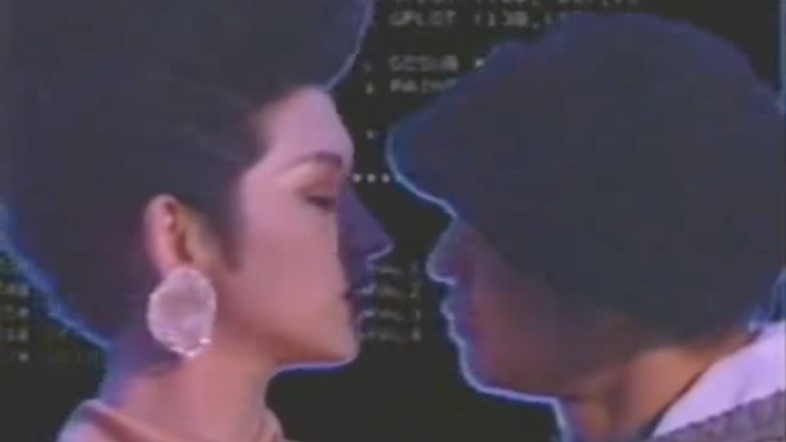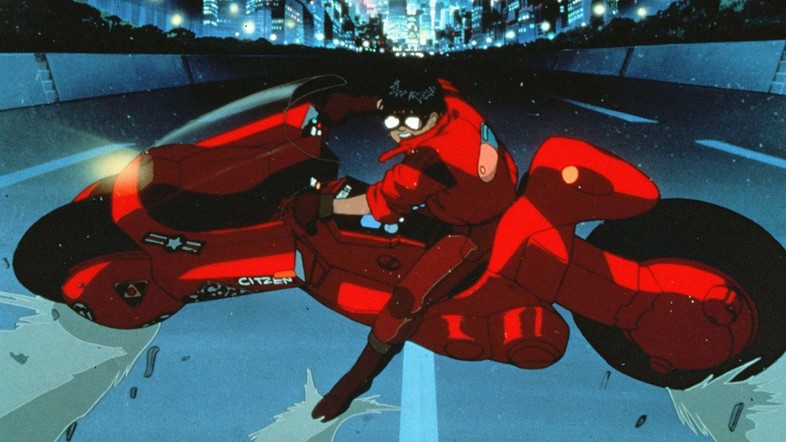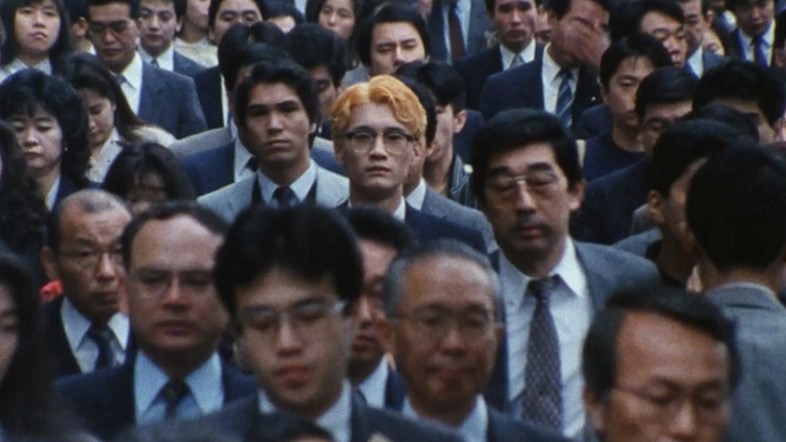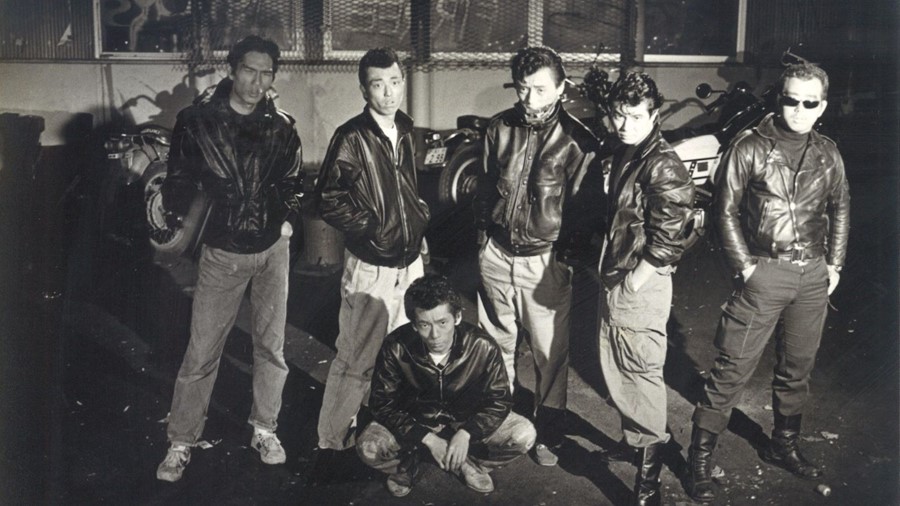From Crazy Thunder Road to Akira, James Balmont talks us through five thrilling Japanese features within the cyberpunk canon
By the 1980s, Japan’s profound post-war economic recovery had reached fever pitch in terms of its global visibility. The island nation had become the second-largest economy in the world – an epicentre for technological innovation as well as a major exporter of manufactured goods, with a vast, high-tech megalopolis as its capital. Many commentators predicted that the country would soon overtake America to become the world’s leading economic power – but factions of a younger generation in Japan were becoming anxious that such rapid industrialisation would eventually spell disaster.
Cue “cyberpunk” – a visionary genre of counter-culture filmmaking that emerged against the backdrop of these anxieties, marrying themes of industry, technology and metamorphosis with images of crumbling dystopias and gut-churning body horror. The genre wasn’t endemic to Japan – in the West, films like Blade Runner and The Terminator, as well as William Gibson’s influential novel Neuromancer (a major influence on The Matrix) also depicted bleak futures based on societies’ decline and advanced tech gone awry – but this kind of fatalistic dystopian filmmaking would always feel more intense in the hands of Japanese creatives. After all, the country was already living in the shadow of an apocalypse – caused by the atomic bombs dropped over Hiroshima and Nagasaki at the end of World War Two.
The Japanese cyberpunk strain is marked by several key elements. In most cases outside of the key anime features Akira and Ghost in the Shell, cyberpunk was a genre born of doggedly independent “punk” filmmaking, usually captured on grainy 8mm and 16mm film. With little in the way of budget, these DIY filmmakers favoured energy, kinesis, impulsiveness and innovation in order to project their heady visions and social commentaries, which often manifested as stories of Frankenstein-esque metamorphosis – usually involving metal, industry or technology. This was usually accompanied by deafening punk, industrial or avant-garde rock music, so as to further amplify a sense of sensory stimulation alongside the wider audio-visual manipulations achieved by the filmmakers’ creative use of editing.
This month, Third Window Films releases a foundational film for the genre this month – Sogo Ishii’s dystopian biker gang battle royale Crazy Thunder Road. With the director’s thematic and aesthetic influence traceable across the entire micro-genre (all the way up to contemporary cyberpunk works like The Matrix Revolutions, Hong Kong’s Limbo and the video game Cyberpunk 2077), Another takes a look back on five thrilling visions within the inimitable cyberpunk canon.
Crazy Thunder Road, 1980 (Lead image)
All roads into Japanese cyberpunk cinema emerged from here: Sogo Ishii’s 1980 dystopian counter-culture classic, Crazy Thunder Road. Despite being heralded for decades – by everyone from entertainment icon Takeshi Kitano to leading film criticism magazine Sight & Sound – it has taken 42 years for the film to be released outside of its home country, until now.
An ambitious university graduation project shot on grainy 16mm from a then 23-year-old director, Crazy Thunder Road takes inspiration from Western classics such as Mad Max and The Warriors to tell a story of warring biker gangs in a near-future dystopia. It’s a world marked by crumbling concrete junkyards, industrial waste and neon-lit warehouses, featuring riff-heavy rock music, frenetic editing and guerilla-style camerawork, all leading towards a dynamite-fuelled climax that belies the meagre budget the film was made for. The results were so impressive that a major studio picked the film up for cinematic distribution – it became a nationwide sensation thereafter.
While the “cyber” element is muted here in spite of the palpable dystopian themes, the filmmaking mentality and aesthetic innovation is as punk as “cyberpunk” gets. A cast of real-life biker gangs sporting chainsaws, butcher’s hooks and metallic jaws, meanwhile, would forecast much of the metal fetishisation that would feature in cyberpunk classics thereafter, including the likes of The Terminator and Tetsuo: Iron Man.

Death Powder, 1986
Sometimes cited as the first film “true” cyberpunk film is the deeply experimental and visually captivating Death Powder, a bizarre and barely comprehensible one-hour short from poet and musician Shigeru Izumiya – who had previously penned a large portion of the music for Crazy Thunder Road, and whom also starred in Ishii’s apocalyptic follow-up feature, Burst City.
Ostensibly, the film concerns conspirators who kidnap an android and transport it to an abandoned warehouse, only for it to disintegrate – releasing a psycho-active substance that warps the minds of all those around it. You’d be hard-pressed to work this out based on the visuals alone, though. Death Powder is surreal to the point of madness – eschewing all but the most basic of plot lines in favour of high-contrast photography, guerilla-style shakycam footage and hallucinogenic audio and video manipulation.
The end result feels like the midway point between Philip K. Dick’s Ubik and David Lynch’s Eraserhead – though perhaps an even more accurate parallel is referred to by the film’s own cage-bound android. Her name, as revealed by a line of on-screen text, is Guernica – referencing the Surrealist monochrome painting by Picasso, which depicts chaos, violence and suffering. It’s a fitting metaphor for the wider cyberpunk aesthetic in itself.

Akira, 1988
Sogo Ishii would unknowingly foreshadow one of the most famous cyberpunk texts of all time, when, in 1981, he directed Shuffle – a delirious 30-minute short about a thug in a gruelling foot-chase, made using money left over from the distribution funds earned for Crazy Thunder Road. This was an adaption of the manga Run, by Katsuhiro Otomo – the man who, seven years later, would deliver an international cyberpunk sensation in Akira, an anime adaption of his 1982 manga series of the same name.
Like Crazy Thunder Road, Akira tells the story of a biker gang in a crime-ridden future – with the latter’s technologically-advanced metropolis of Neo-Tokyo rising from the ashes of a capital city destroyed following the outbreak of World War Three. There, a young ruffian named Tetsuo suffers a horrific motorcycle accident and is then kidnapped by government forces, before being subjected to a series of inhumane experiments. When he re-emerges he finds he possesses powerful psychic abilities – which eventually overwhelm him, causing gross bodily mutations and threatening the existence of the world around him.
Like a nightmarish counterpart to Ridley Scott’s 1982 cyberpunk classic Blade Runner, Akira is widely read as a response to Japan’s own hyper-modernisation in the ‘80s. But Otomo’s reflection was riddled with concern that a disaster metaphorically on par with the atomic bombings of Hiroshima and Nagasaki (which are referenced explicitly in Akira) lurked just beyond the periphery. These fears would be realised when Japan’s economic bubble burst in the early 90s, resulting in decades of economic decline of which the country has never fully recovered.
Akira, though, would be heralded as one of the greatest feats in animation of all time – it earned over $80 million worldwide in home video sales, cementing Japanese anime in the global cultural zeitgeist thereafter.

Tetsuo II: Body Hammer, 1992
Shinya Tsukamoto’s Tetsuo: Iron Man is a text so essential to the cyberpunk canon – and to the wider international recognition of Japanese arthouse cinema in the 90s – that it would be sacrilege to sideline it in any given discussion of the genre. But since I’ve explored it in detail elsewhere, it feels appropriate to take the opportunity to explore the film’s often-overshadowed sequel-remake — which is arguably even better.
The original Iron Man was an Eraserhead-esque black-and-white body horror short set to the sounds of beating metal. Body Hammer retold a similar story – of a salaryman (Tomorowo Taguchi) in dilapidated near-future techno-dystopia who undergoes an excruciating transformation that turns his flesh and body to metal – this time, in cold, crisp polychrome. Hyper-kinetic editing and stop-motion animation only make this disturbing metamorphosis – akin to that seen in films like Alien, The Fly and Robocop – more visceral. The introduction of leather-clad villains sporting buzzcuts and shades, meanwhile, points towards a latter-day Hollywood cyberpunk classic: The Matrix.
Like its predecessor, the film’s production was plagued by crew walk-outs and disruption – partly due to Tsukamoto’s rogue mentality. According to the Tom Mes book Iron Man: The Cinema of Shinya Tsukamoto, one scene depicting the abduction of a child at a mall was shot without informing any locals – leading witnesses to believe they were witnessing a real-life kidnapping. Another resulted in the entire crew being arrested after lead actor Taguchi was rigged up with squibs – which were set off on location right outside a police dormitory.
The Tetsuo franchise continues to be a source of fascination across the globe. As recently as January 2022, a new exhibition opened in Hong Kong to coincide with the launch of new merchandise related to the original films – a project in partnership with Body Hammer’s creature FX designer and regular Tsukamoto collaborator, Takashi Oda.

Anatomia Extinction, 1995
In the near-future, Japan suffers from a nightmarish overpopulation crisis. Tokyo’s streets, highways and public transport face collapse as they reach up to 150% capacity. The police department is privatised in an attempt to control the chaos. And corpses are piling up in the city’s underpasses as stress-induced serial killings dominate the news. In a disturbing twist, it’s revealed that many of the killers have been found to have developed fist-sized tumours inside their bodies — and for one unlucky salaryman, this nightmare is about to become a terrifying reality.
Anatomia Extinction was largely an obscurity in the West before a new restoration and release via distribution label Error 4444 introduced it to a fresh audience in 2021. But it occupies a crucial transitional space in Japanese history. The film premiered in Japan just weeks before the deadly Tokyo subway sarin attacks committed by the Aum Shinrikyo cult movement – which left 14 people dead and over 1,000 injured (a fact made all the more eerie by the film’s frequent allusions to toxic airborne substances in metropolitan areas). But in filmic terms, it also effectively marked the transition of Japanese cyberpunk towards another genre of low-budget filmmaking.
The familiar cyberpunk setting of the deserted subway underpass, where terrifying confrontations take place in murky corners, draws a direct line here from Tetsuo: Iron Man to The Matrix. The trope of having a crazed subject thrashing through crowds at busy Tokyo intersections, meanwhile, can be traced back through Shozin Fukui’s 964 Pinocchio all the way to Crazy Thunder Road. And the weaponisation of body and flesh is lifted directly from one of the most formative movies of the genre as a whole: David Cronenberg’s 1983 techno-sci-fi Videodrome.
But with its garish red-blue colour-scheme, and an emphasis on blood and gory appendages, Anatomia Extinction more readily points towards the splatter-punk genre that would effectively displace cyberpunk in the years hereafter. Director Yoshihiro Nishimura – the director, writer, producer and special effects artist behind Anatomia Extinction, and whom later worked on cult titles like Meatball Machine, The Machine Girl, Tokyo Gore Police and Sion Sono’s Suicide Club – would go on to embody that genre better than anyone. Today, he’s often referred to as “the Tom Savini of Japan” – an appraisal referencing the famed special effects artist behind Dawn of the Dead and Friday the 13th.
